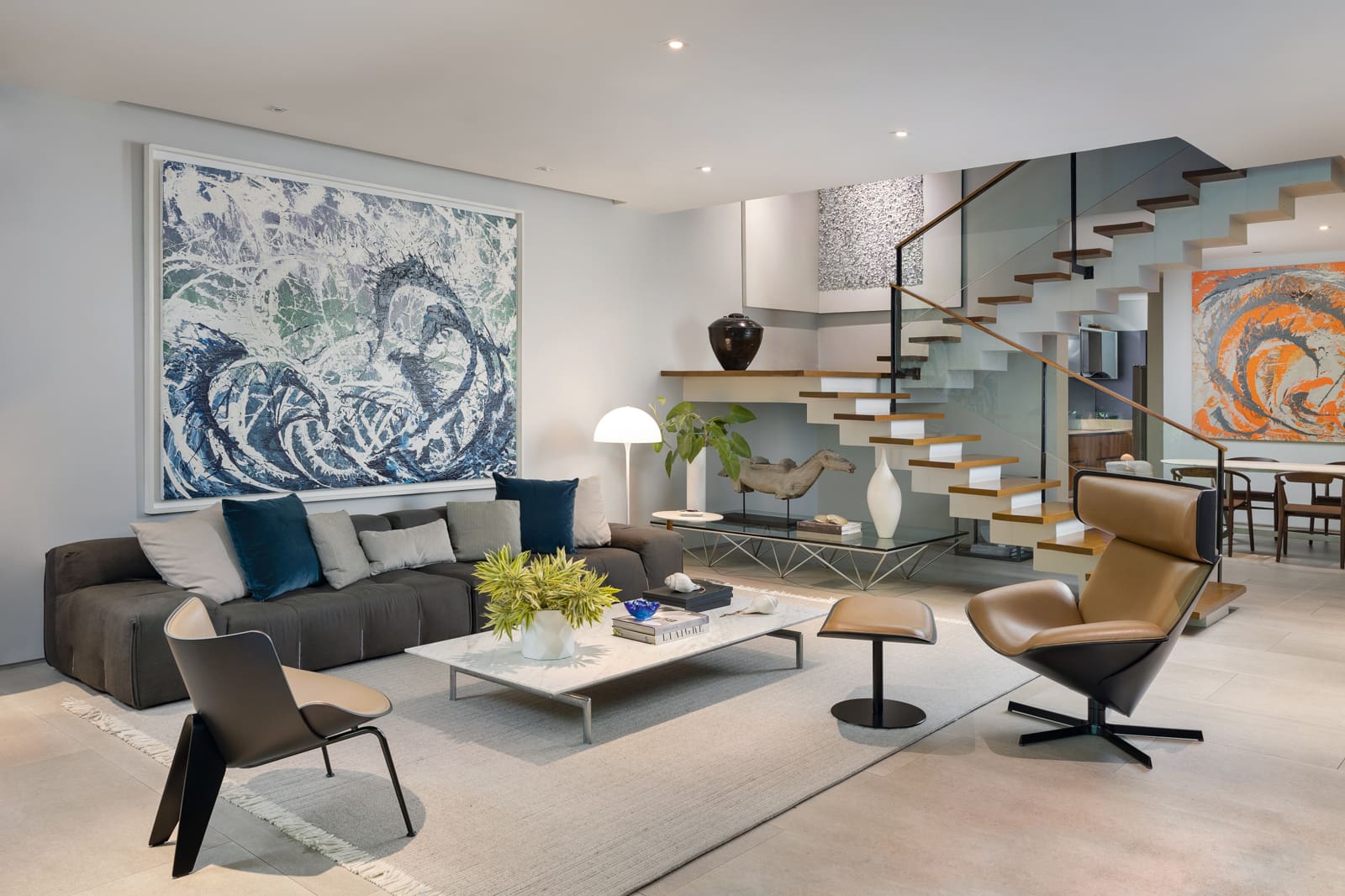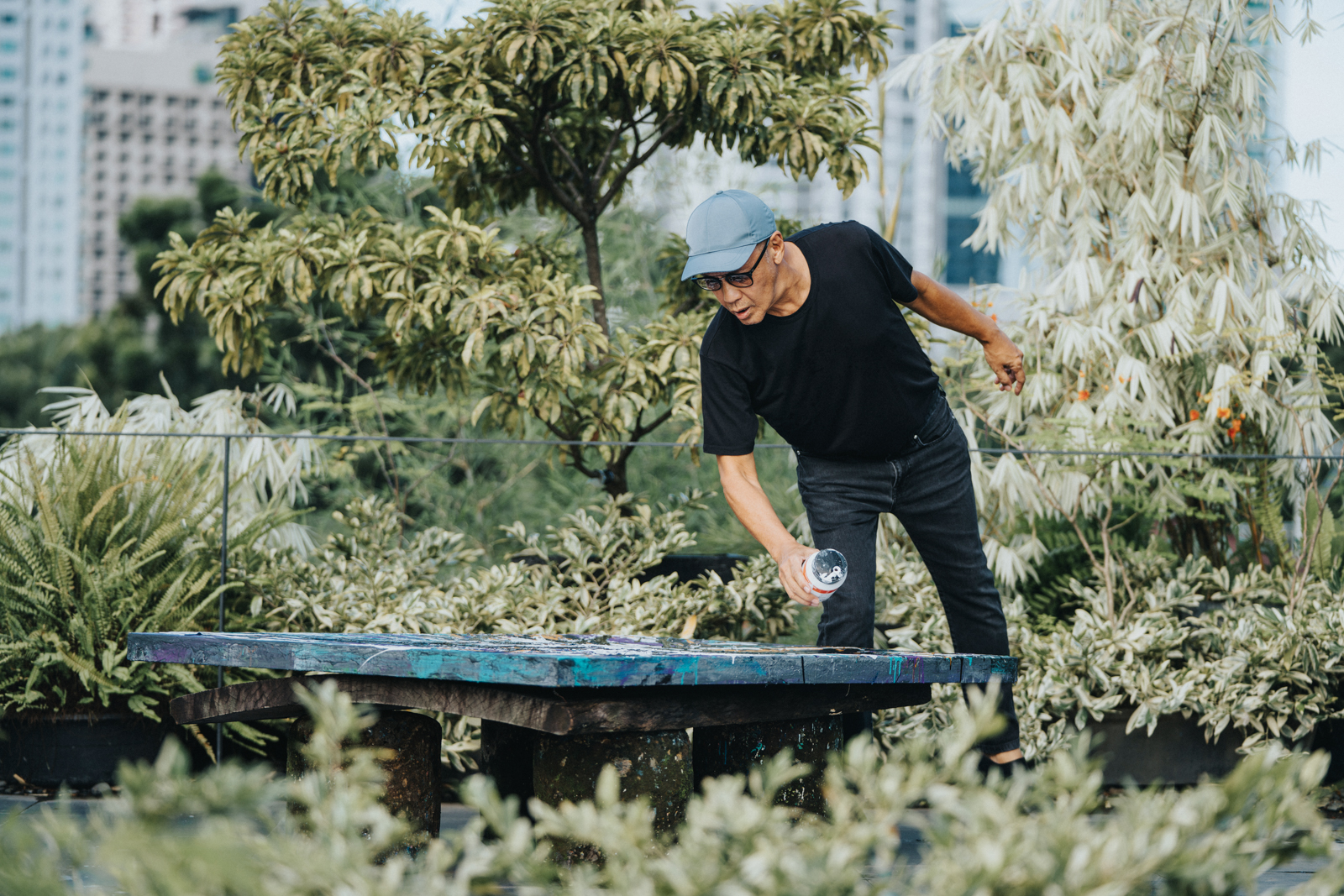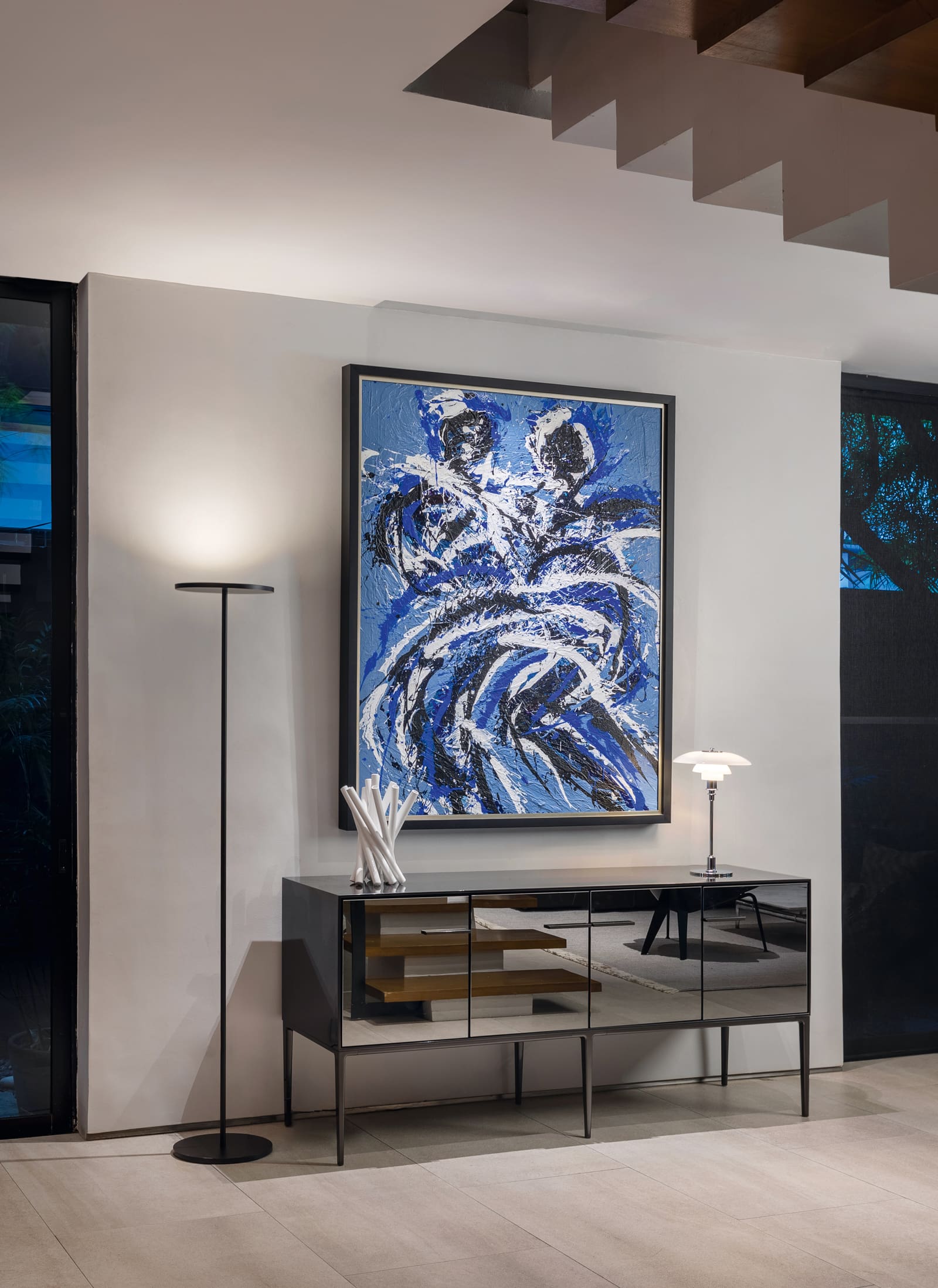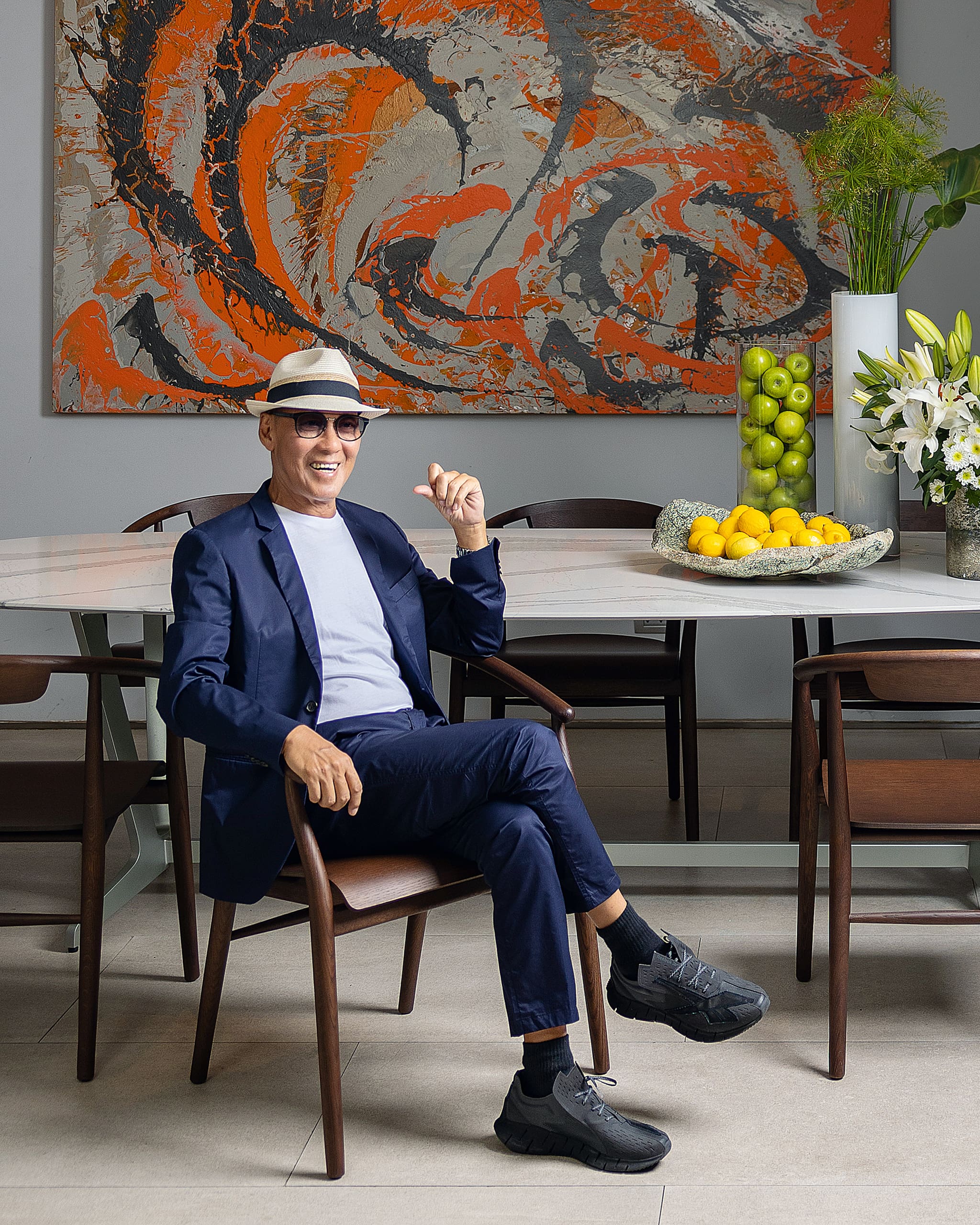Photo by Studio Synthesis
After making his mark in visual art, architecture and hairstyling, the artist now wants to apply his design expertise to a bigger space: the Philippines.
Budji has just “destroyed” his painting yet again, as we settle down in his living room, but this is nothing new. I am used to him painting a masterpiece today, only to instantaneously cover it with layers of acrylic the next day. I saw it happen in his design showroom/home in Bangkok more than a decade ago, where he lived briefly and made a name for furniture design in the Asean region. I saw it happen right in his home in Makati where I and other dinner guests fell in love with a vermillion image of a waterfall, the splash of water seemingly leaping out of the canvas—only for us to learn months later that it was already gone, buried under yet another image.
To Budji Layug, the multi-hyphenate Filipino artist who has helped shape Philippine modern design and architecture in the last decades and whose body of work has gained global market, visual art is fleeting—his completion of a work seemingly an unreachable goal.
His visual art brings him no sense of permanence.
Yet in contrast, his passion for creating burns on and on, even as it sputters sometimes. To this man whom the nation knows on a first-name basis, as “Budji,” life is creativity and vice versa—and it is one moving goal post. It sees no conclusion, and it is this unconsummated passion that has turned him into the visionary in Philippine art and design—one who’s ahead of his time yet who defies classification. More than a decade ago, during the initial deliberation on the nominations for National Artists, I distinctly heard Budji’s name mentioned as a possible candidate for the country’s most prestigious award, but someone at the table asked what category should he fall under—design, visual arts, architecture? The memory of that morning amuses me to this day, but one which Budji brushes off. “You mean not as hairstylist?” he loves to say self-deprecatingly, with a laugh.
Unbeknown to many of this generation, Budji, as Budjiwara, the famous hairdresser of the ’70s, is enshrined in Philippine pop culture, his name sung in the OPM (Original Pilipino Music) hit “Annie Batungbakal” of Hotdog, a name that became iconic even long before this era that uses the term “icon” so loosely.
“Everything in my career is spontaneous,” he says, quite an understatement. Yet a Budji Layug career has become the template for many Filipino creatives of this generation: a wholistic approach to art, design, and lifestyle.
A week after last New Year’s Eve, I get a call from Budji. He’s so excited that he’s on the brink of hysteria. “I’m alive again!” he blurts out and every time he says that, expect the tumble of words out of his mouth, this artist whom Manila falsely thinks is an introvert.
“Just came from Bangkok. I got so energized. The design, the integrated wellness. We can be Bangkok. Global, modern aesthetic and lifestyle. Bangkok, Singapore, Hong Kong—I saw these even before they could have the skyscrapers. Manila was ahead then,” he goes on.
“I’m not just about painting. I really want to plan and design space, living space that includes wellness and the urban quality of life… but this time not just a home, but a community. It’s about time we thought Philippines. That would give me fulfillment now, to be able to design for the country, with wellness and quality of living integrated in it.”

Then Budji reveals the vision resulting from his “aha” moment in Bangkok. He wants to build a Design Institute in the south that will encompass art (gallery), knowledge (workshops), lifestyle (café), and wellness. It will be his way of sharing his expertise and vision not only with the upcoming generation of creatives but also with government bureaucrats who want to build their communities, or with the ruling Establishment that is woke, and open to the design of a modern global Philippines.
Not far behind its neighbors, the Philippines, over the decades, has nurtured a modern, contemporary aesthetic while mining its indigenous material and craft, from bamboo, rattan to mother of pearl. Budji became the first Filipino to be recognized by Bloomingdale’s for his bamboo furniture—the young Budji made the Philippine bamboo go global—the Filipino whose body of work includes not only private homes, but also Philippine pavilions in world expos and Philippine infrastructure such as airports. He became known for the Asian Modern in Philippine design, utilizing space planning for the Asian Modern or Tropical Modern, and blending concrete, glass and steel with Philippine wood, flora and greenery—but in clean, almost spare lines. It is not rustic, but modern. Nothing decorative or ornamental. In his words, it is “letting the outdoor in, and letting the indoor out.” It is integrated space planning and design. The streamlined modern environment is softened by his furniture design that suits the interior as well as the outdoor setting, or by a Budji mural of figurative trees that seem to flow out into the panoramic garden outside—seamlessly.
When we sat down with him before the holidays, his mind was still on his art—how, to him, a painting is a solitary journey, and a potential source of self-fulfillment. After two decades spent on design projects (private homes, offices and public infrastructure), he was out to satisfy only himself this time. The country was not in the picture at all.
To go back to that dinner conversation, after he has just layered, yet again, on a painting in progress:
“The process is to layer on, to discover more of what I feel, it’s not easy. Until something new, different comes up, and leaves me satisfied, I can even change the subject matter altogether. I don’t stop,” he describes the unfinished work on his canvas.
Budji cannot even conclusively describe his style.
In his youth, he d id portraiture (the portraits of his mother and his son David are, to me, priceless), then he went figurative with his Movement series (Dance)—figures in motion that are energetic but fluid, dynamic strokes—then nature and landscapes, the wave (Wave series) and the waterfall appearing ethereal yet powerful. There’s also the popular Sabungero series, his well-received foray into the abstract.
What arouses him now is abstract expressionism. “I want to reduce (art)…the simpler it is, the harder.”
Painting gives Budji self-satisfaction—for now. “I like it to appeal to myself, not to a market. It’s a source of satisfaction, but also of deep frustration, when I don’t get what I want.”
When does he achieve what he wants as he applies acrylic on the canvas—not even he can identify that point. “It’s a never-ending desire. I don’t want to repeat myself lest I get bored.”

He cannot even identify what or who inspires him, save that he learns from the masters like Monet, Cezanne, and the modern artists like de Kooning, Pollock. He’s especially drawn to the Chinese artist Zaowouki and his Oriental way of landscape abstraction. “He lived in Paris during Picasso’s time. I love his creativity, originality, his identity that remained distinct even as he painted with the masters in Paris.”
Paris. London. Frankfurt. New York. California. Budji hardly stayed put in the Philippines. The world raised Budji—as a young man, as an artist, as an adventurer, as bon vivant.
Barely two months after graduating from high school, Budji was asked by his mother, Herminia Cancio Layug, if he wanted to go to New York to study. Now what footloose teen would say no to that, and Budji, the second son in a family of eight, was raring for world adventure. He stayed briefly in Los Angeles, then flew to New York where he studied design in the School of Interior Design.
“It was adventure I was after. I went to school to be able to stay in a country,” he recalls without guilt.
From New York, his mother let him go to Europe to be exposed to the arts and life there. In the intervening years that followed, he studied art in Paris, graphic design in Germany, and, in a Machiavellian move because he wanted to live there, he enrolled at Vidal Sassoon in London to study hair style. Before this extended life in Europe, however, his mother asked him to enroll in Architecture at UST. It was not in the nature of youth, and certainly not in Budji’s DNA, to stay put in one place, certainly not in a confining institution like a university.
Leaving behind a goodbye letter to his mom—and the privilege of parental allowance—he flew to Paris. Then it was off to Germany and London.
It was in that London stint that he learned how to do hair, and when his mother asked him to come home, he opened his Budjiwara salon, which became the destination of Manila’s high society which loved a Budji cut. He’d cut hair once a week and would spend the rest of his time exploring the country, from the upland Baguio down to the coastal beaches, where he grew to love Philippine craftsmanship, from the basket weaving of Ilocos which he found showcased in the Baguio market, to the bancas and bamboo benches on the beaches of Batangas. He worked with the fisherfolk and craftsmen to develop bamboo furniture. It was this bamboo furniture design series (Peacock Chair is now iconic) which he had the guts to show Bloomingdale’s in New York. Bloomingdale’s was impressed and included it in its China Exhibit. Then Bloomingdale’s decided to hold a Philippine exhibit featuring Budji’s bamboo furniture and Imelda Marcos’ ternos. This was in the ’70s and as early as then, Budji was going global. Budji also made furniture for Ralph Lauren’s Caribbean holiday home.
Budji blazed the trail in furniture and home design in the country—a fact made more pronounced when the design visionary Eli Pinto, then head of Citem, tapped him to form a group which would become known in the world as Movement 8. Budji enjoyed this phase of his life, which spanned more than a decade, because it linked him with the country’s designers, manufacturers, craftsmen—but this time, Budji cast his eye on modern technology, not just craftsmanship, to give the Philippines a seat at the global table. “Eli made me work with all kinds of materials and processes, all over the country.”

From where we sat on the front row of Budji’s career and life, it was apparent how he was leaving his mark on art, design and lifestyle. His furniture design led him to home design, building as early as the ’80s the Zulueta home in Tagaytay which—with its round, organic shape that gave a 360-degree panoramic view of the ridge—would become a visual icon.
From childhood, growing up in a family of architects and designers, Budji had been drawn to architecture. “Architecture, to me, is the basis of other arts—visual arts, interior design, furniture design,” he claims.
“Travel was my self-taught education. I learned from the world, living in various cities. Art, design, architecture, fashion, lifestyle. If you were to ask me what my subject was, it would be adventure!”
Budji espouses total integrated design, the creation of unified spaces that go beyond the interiors into the landscape. His take from having worked in the design sector for at least two decades: “Architecture and design are one. Design is integral to, not inferior to architecture.”
While he is tantalized by the idea that his painting could be gaining international clientele—in fact, as early as the ’90s, I interviewed a visiting HK executive who, to my surprise, said he had in his collection a Filipino artist, and he named Budji whom he never even met—he now sets his sights on a still bigger picture. He wants to design unified spaces, into a brand that is distinct, one, and not isolated spaces. He has the bigger environment, the community in mind, indeed the country. He doesn’t see why the Philippines should not be one creative global brand in design and in lifestyle.
“I’m ambitious not just for my design now, but for a nation’s vision,” he says, fired up for the new year. It is yet another new beginning for Budji.
